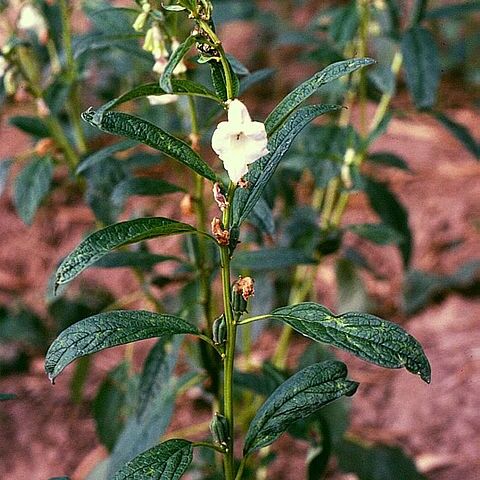Erect or prostrate herbs, often viscid pubescent with glandular hairs and with subsessile glands. Leaves opposite, but sometimes with alternate or cyclical leaves above, entire, serrate, lobed or dissected and sometimes pubescent with subsessile, peltate 4-celled trichomes and with elongate hairs, mostly petiolate. Inflorescences solitary flowers in the upper leaf axils, pedicellate or subsessile; bracts and bracteoles, wanting or obsolete. Flowers sometimes showy, yellow, red, purple or pink; calyx deeply 5-lobed, the lobes similar; corolla campanulate, 5-lobed, slightly 2-lipped, slightly gibbous basally, glandular with short-stipitate 2-4 celled glands; stamens 4, the anthers oblong, versatile, the locules parallel, the connective dorsally thickened and terminated by a gland; ovary oblong, the locules longitudinally demarcated, hispid, the style abrupt, slender. Capsule ob-long, longitudinally grooved or 4-angled, opening apically; seeds numerous, sometimes compressed, smooth or ridged, sometimes rugose, minutely 4-angled.
Annual or perennial, erect or procumbent herbs. Leaves sessile or petiolate, entire, lobed or partite, often varying on the same plant. Flowers solitary in the leaf axils, shortly pedicellate, white, pink or purple, sometimes spotted within. Calyx persistent or deciduous. Pedicels usually short, with nectarial glands at the base. Corolla foxglove-like, obliquely campanulate, limb sub-bilabiate, lowest lobe the longest. Filaments slender; anthers dorsifixed, cells parallel, connective gland-tipped. Disc annular, regular. Ovary 2-celled, subcylindrical; cells divided almost to the apex by a false septum; ovules numerous, 1-seriate in each division. Capsule oblong or sub-obconical, grooved, beaked at the apex. Seeds numerous, obovate, compressed, winged or wingless, smooth or rugose.
Plants terrestrial, annual or perennial herbs, rarely shrubs. Leaves entire or digitate. Flowers solitary. Pedicel short. Calyx deciduous or persistent. Corolla white, pink, to purple, obliquely campanulate, obscurely bilabiate; lowest lobe longest. Disc glandular. Ovary 2-locular, divided by a false septum almost to apex. Ovules numerous, uniseriate in each locule. Fruit a longitudinally dehiscing capsule, oblong to obconical, 4-sulcate, beaked. Seeds obovate, compressed, winged, fringed, or rarely smooth; testa smooth or rugose.
Fr a columnar, unarmed, 4-locellar capsule, dehiscent only at the summit; cal 5-cleft, nearly regular; cor campanulate, the limb oblique, the lower lobes the larger; stamens 4, straight, with parallel pollen-sacs; herbs with solitary, axillary fls, the upper lvs generally alternate. 20, Africa and India.
Annual or perennial, erect herbs, sometimes shrubs (not in the Flora Zambesiaca area) Leaves sessile or petiolate, lamina entire, lobed or digitate, often varying on the same plant.
Fruits longitudinally dehiscent capsules, cultrate to narrowly oblong or obconical in lateral view, 4-sulcate, rostrate at the apex.
Ovary bilocular, subcylindrical; loculi divided almost to the apex by a false septum; ovules numerous, uniseriate in each division.
Flowers solitary in the leaf axils, shortly pedicellate with extra-floral nectaries (reduced flowers) at the base.
Seeds numerous, obovate, compressed, winged or with a double, rarely single fringe, testa smooth or rugose.
Corolla white, pink or purple, obliquely campanulate, limb sub-bilabiate, lowest lobe the longest.
Anthers dorsifixed, thecae parallel, connective gland-tipped.
Calyx persistent or deciduous.
Disk annular, regular.

